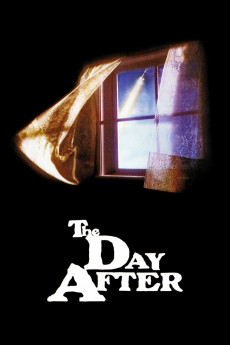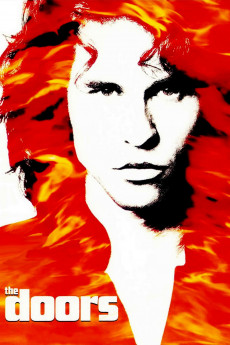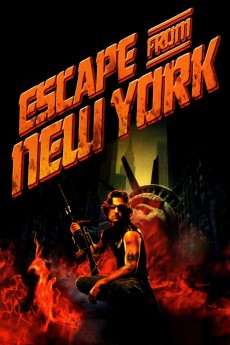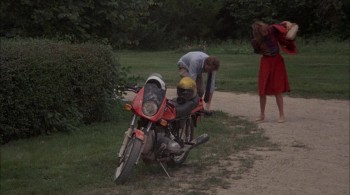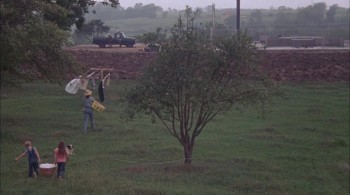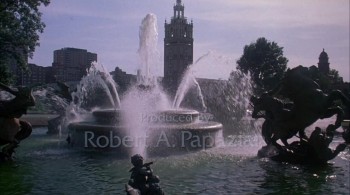The Day After (1983)
1983
Action / Drama / Sci-Fi
The Day After (1983)
1983
Action / Drama / Sci-Fi
The Day After (1983) Synopsis
While the movie contains significant exposition to explain the onset of the war, the plot lies in the human struggles of the characters. The film follows several average citizens and the people they encounter after a nuclear attack on Kansas City, Missouri.The chronology of the events leading up to the war is depicted entirely via television and radio news broadcasts. The Soviet Union is shown to have commenced a military buildup in East Germany with the goal of intimidating the United States into withdrawing from West Berlin. When the United States does not back down, Soviet armored divisions are sent to the border between West and East Germany.During the late hours of Friday, September 15, news broadcasts report a "widespread rebellion among several divisions of the East German Army". As a result, the Soviets blockade West Berlin. Tensions mount and the United States issues an ultimatum that the Soviets stand down from the blockade by 6:00 A.M. the next day, or it will be interpreted as an act of war. The Soviets refuse, and the President of the United States puts all U.S. military around the world at DEFCON 2.On Saturday, September 16, NATO forces in West Germany invade East Germany through the Helmstedt checkpoint to Free Berlin. The Soviets hold the Marienborn corridor and inflict heavy casualties on NATO troops. Two Soviet-built MiG-25RBs cross into West German airspace and bomb a NATO munitions storage facility but also hit a school and a hospital. Through a radio broadcast, viewers learn that Moscow, USSR is being evacuated. At this point, people in major U.S. cities are shown to begin mass evacuations, foreshadowing the impending doomsday. There follow unconfirmed reports that nuclear weapons were used in Wiesbaden and Frankfurt, West Germany. Meanwhile, in the Persian Gulf, naval warfare erupts, as radio reports tell of ship sinkings on both sides.Viewers then learn that the Soviet Army and other Warsaw Pact armies have reached the Rhine river having captured most of West Germany in less than six hours. Not wanting Soviet forces to invade France and have the rest of Western Europe fall, the United States halts the Soviet advance by airbursting three low-yield nuclear bombs over advancing Soviet troops. Soviet forces counter by launching a nuclear strike on NATO headquarters in Brussels. In response, the United States Strategic Air Command begins scrambling some of its nuclear-armed B-52 bombers in preperation of further nuclear first strikes or retaliations.After the initial nuclear exchange in Europe, the United States is shown to enact its "launch on warning" policy: it launches a full-scale nuclear attack on the Soviet Union if and when the United States receives indication that the Soviet Union is preparing to do the same.The Soviet Air Force then destroys a BMEWS (Balistic Misssle Early Warning Station) at the RAF Airbase in Fylingdales, England and another at Beale Air Force Base in California with low kiloton nuclear weapons. Meanwhile, on board the EC-135 Looking Glass aircraft, the order comes in from the President of the United States to launch a full nuclear strike against the Soviet Union. Almost simultaneously, an Air Force officer receives a report that a massive Soviet nuclear assault against the United States has been launched, stating "32 targets in track, with 10 impacting points." Another airman receives a report that over 300 Soviet ICBMs are inbound. (It is deliberately unclear in the film whether the Soviet Union or the United States launches the main nuclear attack first.)Dr. Russell Oakes (Jason Robards) is a doctor who lives in the well-to-do Brookside neighborhood of Kansas City with his wife (Georgann Johnson) and works in a hospital in downtown Kansas City. On the day of the nuclear attack, he is scheduled to teach a hematology class at the University of Kansas hospital in nearby Lawrence, Kansas, and is en route from Kansas City to Lawrence on a jammed highway when he hears an alarming Emergency Broadcast System alert on his car radio. He pulls off the crowded freeway, attempts to contact his wife from a nearby phone booth, but gives up due to the incredibly long line at the booth. Oakes then heads back down I-70 toward Kansas City to find his wife, although he is the only eastbound motorist on the freeway at the time.The first salvo of the Soviet nuclear attack on the central United States (as shown from the point of view of the residents of Kansas and western Missouri) occurs at 3:38 PM Central Daylight Time when a large yield nuclear weapon is air burst at a high altitude over Kansas City, Missouri, in order to generate an EMP (electromagnetic pulse) and disable any defensive weapons covering the nearby Minuteman III missile silos of Whiteman AFB. 30 seconds later, incoming Soviet ICBMs begin to impact military and population targets, including Kansas City. Sedalia, Missouri, all the way south to Eldorado Springs, Missouri, is blanketed with ground burst nuclear weapons.The nuclear attack is soon initiated and Kansas City is gripped with panic as air raid sirens wail. Oakes' car is disabled by the electromagnetic pulse, along with other motor vehicles and the city's electricity. Oakes is about 30 miles away from downtown Kansas City when the missiles hit. His wife, son, daughter, possibly many of his colleagues as well as countless other people are killed in the attack. After the explosions, Oakes walks ten miles the other way back to Lawrence and finds his way to the university hospital where he treats the wounded with Dr. Sam Hachiya (Calvin Jung), Nurse Bauer (JoBeth Williams) and other aid workers.At another part of the university, science Professor Joe Huxley (John Lithgow) rallies a group of his students together and utilizes a Geiger counter to monitor the level of nuclear fallout outside, which measures at more then 50 RADS per hour. They also build a makeshift radio to maintain contact with Dr. Oakes at the hospital, as well as contact any other broadcasting survivors outside the city.Billy McCoy (William Allen Young) is an Airman First Class in the United States Air Force stationed at Whiteman AFB near Kansas City who is called onto duty during the DEFCON 2 alert. He and his colleagues are among the first to witness the initial missile launches signaling the start of a full-scale nuclear war. After it becomes clear that a Soviet counterstrike is imminent, the unit panics and becomes involved in a heated argument; several Airmen stubbornly insist that they stay on duty while the others, including McCoy, point out that any further action by this stage is essentially futile and that they would almost certainly die if they remained at their posts. McCoy attempts to drive away on a truck, but is forced to abandon it when it is disabled by the EMP blast from the Soviet missiles. He then manages to find an abandoned bunker to hide in and barely escapes the oncoming nuclear blast. Afterward, he emerges from the bunker and walks towards a town, only to find it abandoned; he enters an abandoned store, taking a large amount of candy bars for food and then continues walking in hope of finding other survivors. He befriends another man, traumatized from the events, with whom he shares his candy bars. Soon, McCoy and the other man both begin to suffer from the effects of radiation poisoning. They learn that the closest hospital still functioning is the one in Lawrence and decide to trek there. They eventually reach the hospital, only to succumb to radiation sickness shortly thereafter.Jim Dahlberg (John Cullum) is a local farmer whom he and his family live in rural Harrisonville, Missouri, far outside Kansas City, but very close to a field of missile silos. While those near the impact zone die or become sick quickly, the Dahlbergs develop symptoms of radiation sickness slowly, as they had prepared their basement as a makeshift fallout shelter. They also face the looting and chaos that come after the explosion. During the initial attack, the Dahlbergs' son accidentally stares directly at a nuclear explosion and becomes flash blinded. The family also reluctantly accept a University of Kansas student named Stephen Klein (Steve Guttenberg), who had been hitchhiking to his home in Joplin, Missouri, from school at the time of the attack.After several days, the eldest daughter, whose marriage had been scheduled for the day after the attacks occurred, runs outside panicking into the fallout infected wasteland. Stephen goes after her and manages to bring her back into the house. After this ordeal, the family decides to go out and look for survivors. They discover a church and eventually they figure out that their daughter is contracting radiation sickness. The son is also not doing too well; his blindness does not recover and he does not heal well. Stephen decides to take them both to the hospital at the University of Lawrence. At the hospital, the daughter starts to exhibit the symptoms of radiation sickness and begins to lose her hair. To comfort her, Stephen removes his cap and reveals that he too has lost the entire top of his head of hair. It is indicated that they all have terminal radiation sickness and will die. When the daughter's parents try to return home, they encounter food-seeking people. The angry people shoot and kill Jim as he asks them to leave.While there are no specifics given, it is strongly suggested in the film that America's cities, military, and industrial base are largely heavily damaged or destroyed. Eventually, the unseen American President gives a radio address in which he declares that there is a ceasefire between the United States and the Soviet Union, which suffered similar catastrophic destruction.Several days later. Dr. Oakes wakes up and discovers that Nurse Bauer has died of meningitis. Being almost completely broken, Oakes decides to ask Dr. Hachiya to come with him back to Kansas City where he says he will "see my home one last time before I die". Hachiya shudders and refuses. He knows that he must help the patients and cannot risk dying. Oakes then reluctantly resolves to return to Kansas City on his own. He travels an uncertain distance on foot before managing to hitch a ride on a U.S. Army National Guard truck, where he witnesses US military personnel blindfolding and executing looters without a trial. He then makes his way to the former site of his home, where he finds the charred remains of his wife's wristwatch, as well as a family huddled in the ruins of the house. He angrily orders them to leave. The man in charge of the family does not speak, but offers Oakes food, causing him to withdraw and collapse in tears.The film fades out with Oakes and the unnamed occupant of his "house" crying in an embrace and Professor Huxley forlornly calling into his makeshift radio: "Hello? This is Lawrence, Lawrence, Kansas. Is anybody there? Anybody? Anybody at all...?"
Published Time: 2018-08-09 19:26:40

